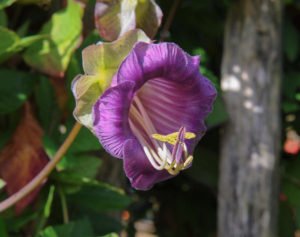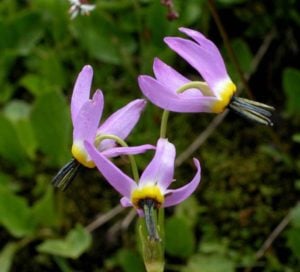Many of us, choosing a plant for the border, want it to be decorative, eye-catching, while well framed paths or favorably emphasized bright flower beds. Cineraria is what you need!
Cineraria has many species that are very different from each other in appearance: herbaceous flowers and ornamental shrubs. Cineraria flowers are very diverse in color, size and shape. A variety of silver beauties — Cineraria maritima planted as decorative foliage plants: its graceful silvery foliage looks great in borders, and mixed borders.

Cineraria belongs to the Asteraceae family. Genus cineraria close to the genus Ragworts, it includes some species common in Amateur gardening. All types of cineraria already has about 1300. In this article we will look at the most commonly used in our gardens.
Since the types of cineraria are very different in their preferences, requirements and methods of reproduction, for each planting and care will be described separately.
Cineraria cruenta or Senecio cruentus
Homeland of this species-the Canary Islands, an annual plant with oval light green leaves. Often this plant is confused with Bellis because of the similarity of flowers. They, in turn, can be a variety of delicate shades. Once I bought cineraria in a pot in a flower shop, really liked her pale pink flowers, but after flowering the plant began to die.

Planting and growing of Cineraria cruenta
Cineraria cruenta is more often grown in pots, because it has a long growing season: flowers appear only 8-9 months after seed planting. However, Cineraria cruenta can decorate a garden, if you plant seedlings in the winter and after transplanting young plants in the ground. Cineraria loves heat and humidity.
- Seeds for seedlings are planted in December, they are very small, so they are not buried in the ground, but put on wet, loose prepared soil from above, pressing a little. It is better to cover them, before shoots, glass.
- Seeds are grown at a temperature of + 18…+20°C, condensation from the glass must be removed.
Shoots appear after 2 weeks after planting. - Transplanting seedlings can be when the plant will have the first two leaves. After that, the temperature is lowered to +15°C to form flower buds.

In late spring, the plants are transplanted into the ground. This kind of cineraria demanding to soil moisture, therefore, requires a well-drained soil before planting. It should grow in a lighted place, but that the sun did not fall direct scorching rays. From lack of sunlight suffers flowering. Despite the love of moisture, pour it is not necessary, and should avoid stagnation of water, otherwise there will be rot of the root system.
Cineraria cruenta blooms by autumn. Flowering lasts a little more than a month. The plant does not tolerate frost, can withstand temperatures up to -2°C.
Today there are many hybrids Cineraria cruenta, which are different in height, shape of the Bush and colors. For example, small flowers in the form of stars with a long stem from 70 cm blooms “Stellata”.

Dense small bushes with bright flowers blooms cineraria “Nana”.

Large and bright blossoms are different “Grandiflora”, which reaches 50 cm in height.

Cineraria maritima
I won’t be disingenuous, this view is my favorite. It is good for the border, and as an ornamental plant, framing planting bright colors, and in street vases and containers. This species is considered a perennial, but most plant it as an annual plant.

Cineraria maritima is completely different from its above-described relative. Carved leaves are pubescent and silvery, thanks to this plant is also called romantic “silver dust”. Inflorescences of this species consist of nondescript yellow flowers and is not decorative. Many gardeners simply remove them, so as not to spoil the view.

Planting and growing of Cineraria maritima
Cineraria maritima grows much faster than its relative, Cineraria cruenta. Seeds for seedlings are planted in March, shoots will appear in 10 days, after which they are transplanted. It is necessary to feed the seedlings with mineral fertilizers. In late may, seedlings can be planted in the ground. The distance between plants take about 15 cm.

From personal experience I can say that no matter how much I tried to plant directly into the ground under the film, it was not possible to get the desired result. Therefore, I advise the seedling method. Cineraria maritima is also well propagated by green cuttings.
This type of cineraria is not demanding on the composition of the soil, but it grows better on “crumbly” light soils, slightly acidic also suitable. The sun for this type of cineraria is of great importance, because it is in the sun that the leaves are poured with a rich “white” color. Watering cineraria is required only at the beginning of growth, further the plant is completely undemanding to moisture.

Popular varieties of Cineraria maritima
‘Cirrus’. This variety is characterized by oval leaves with wavy edges, they are not carved, as in some varieties, and solid, green-silver color. Than older the plant, the more its color changes to silvery white. The height of the plants of this variety is about 45 cm.

‘Silver Dust’. This variety belongs to the undersized. The height of its plants reaches about 25 cm, the leaves are carved, silvery-white.

Senecio elegans
This more “wild” sister of the above mentioned cineraria came to us from South Africa. We grow it as an annual plant. In the rosette at the roots leaves pinnate dissected, the leaves are sticky hairs. Flowers in double or simple flowers, in various shades. Tubular flowers in the center of yellow. From June until the autumn flowering of this species continues.

Senecio elegans doesn’t look as lush as her relatives but she’s much more unpretentious.
Planting and growing Senecio elegans
The place is necessarily Sunny, rich in organic and mineral fertilizers soil, neutral or slightly alkaline. This species can be sown directly into the soil as soon as the earth thaws and warms up a little, many gardeners do so. The distance between plants to take about 15-20 cm I have, by the way, in due time with this sowing has not grown. Therefore, in order not to think about shoots, it is better to grow seedlings.
- Seeds for seedlings should be sown in early April in boxes or immediately in the greenhouse.
- When the seedlings have the first pair of leaves, they dive into separate pots and slightly lower the temperature.
- In mid-may, the finished seedlings are planted in the ground.
In Senecio elegans need to remove the faded head to extend its flowering period.
So, if you really like lush flowering bushes Cineraria cruenta, you can try to grow it in the garden, but it is troublesome because of the long growing season, and in fact every year will have to repeat the procedure. Best choice for garden — Cineraria maritima, tints and emphasizing its fine silvery foliage and other flowers. There is evidence that even without insulation this plant is able to winter and continue to please the eye for several years. And the easiest to plant and care of all — Senecio elegans, which can be successfully planted in flower beds and flower beds, combining with other plants.






